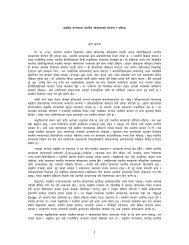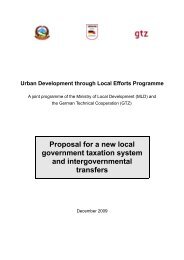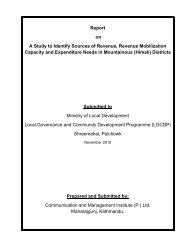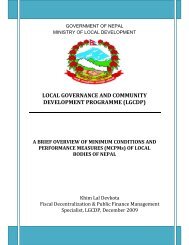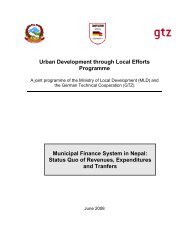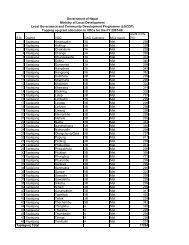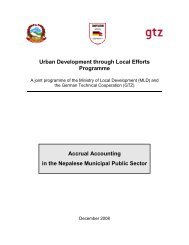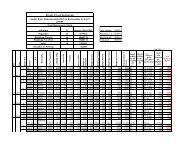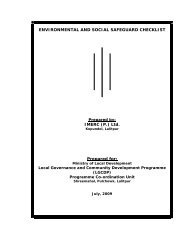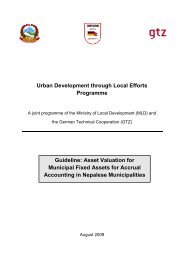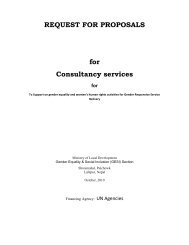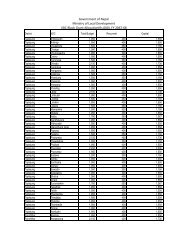Local Government Finance in Nepal - LGCDP
Local Government Finance in Nepal - LGCDP
Local Government Finance in Nepal - LGCDP
You also want an ePaper? Increase the reach of your titles
YUMPU automatically turns print PDFs into web optimized ePapers that Google loves.
Urban Development through <strong>Local</strong> Efforts Programme<br />
A jo<strong>in</strong>t programme of the M<strong>in</strong>istry of <strong>Local</strong> Development (MLD) and<br />
the German Technical Cooperation (GTZ)<br />
<strong>Local</strong> government f<strong>in</strong>ance <strong>in</strong><br />
<strong>Nepal</strong><br />
Current situation, challenges and future policy<br />
June 2008
Report submitted by Dr Alexander Wegener,<br />
<strong>in</strong>terpublic consultancy,<br />
Alexander.Wegener@<strong>in</strong>terpublic-consultancy.de<br />
on behalf of GTZ for GTZ/udle<br />
2
Table of Content<br />
1 Introduction: What this document is about...........................................1<br />
2 Municipal <strong>F<strong>in</strong>ance</strong> at the crossroads.....................................................1<br />
2.1 Revenue composition...........................................................................................3<br />
2.1.1 Revenue composition and trends..............................................................8<br />
(a) Tax revenue composition.....................................................................8<br />
(b) Non-tax revenue composition..............................................................9<br />
2.1.2 Growth rates of selected revenue titles...................................................11<br />
2.1.3 Tax review reveals <strong>in</strong>consistencies and potentials..................................14<br />
(a) Value added tax.................................................................................14<br />
(b) Land and property taxes....................................................................14<br />
2.2 Per Capita Revenue............................................................................................15<br />
2.3 Grant and LDF allocation....................................................................................18<br />
2.3.1 WTO accession requires abolition of local development fee..................18<br />
2.3.2 Compet<strong>in</strong>g grants reduce capacity build<strong>in</strong>g efforts.................................18<br />
3 Policy recommendations for gtz/udle <strong>in</strong> promot<strong>in</strong>g local government<br />
f<strong>in</strong>ance <strong>in</strong> <strong>Nepal</strong>......................................................................................21<br />
3.1 <strong>Local</strong> government f<strong>in</strong>ance...................................................................................22<br />
3.2 Intergovernmental fiscal transfers.......................................................................23<br />
3.3 Account<strong>in</strong>g and f<strong>in</strong>ancial management practice.................................................24<br />
4 References..............................................................................................25<br />
iii
List of Tables<br />
Figure 1: Factors <strong>in</strong>fluenc<strong>in</strong>g the situation of local government f<strong>in</strong>ance <strong>in</strong> <strong>Nepal</strong>.............2<br />
Table 2: Revenue titles for municipalities..........................................................................3<br />
Figure 3: Municipal revenue composition <strong>in</strong> <strong>Nepal</strong>............................................................5<br />
Figure 4: Municipal tax revenue composition <strong>in</strong> <strong>Nepal</strong>......................................................6<br />
Figure 5: Municipal tax revenue composition <strong>in</strong> <strong>Nepal</strong> (exclud<strong>in</strong>g LDF and former octroi)<br />
.............................................................................................................................7<br />
Figure 6: Municipal revenue composition <strong>in</strong> <strong>Nepal</strong> as a share of annual total revenue..10<br />
Figure 7: Growth rates of selected municipal revenues to previous year.......................12<br />
Figure 8: Growth rates of selected municipal revenues to previous year.......................13<br />
Figure 9: Total revenue and total population <strong>in</strong> the fiscal year 2005/2006......................16<br />
Figure 10: Per capita revenue and total population (exclud<strong>in</strong>g Kathmandu) <strong>in</strong> the fiscal<br />
year 2005/2006..................................................................................................17<br />
Figure 11: Grants allocated to municipalities...................................................................19<br />
Figure 12: Grants by type allocated to municipalities......................................................20<br />
Figure 13: Design pr<strong>in</strong>ciples of local taxation..................................................................22<br />
iv
Please note: This document is best viewed with Adobe Acrobat Reader 8.0. A pr<strong>in</strong>t-out of this document<br />
<strong>in</strong> black and white cannot display the orig<strong>in</strong>ally coloured figures.<br />
v<br />
<strong>in</strong>terpublic berl<strong>in</strong><br />
Dr. Alexander Wegener<br />
<strong>in</strong>terpublic berl<strong>in</strong> Wegener & Wegener GbR<br />
Sundgauer Straße 100<br />
D-14169 Berl<strong>in</strong> (Zehlendorf)<br />
Tel.: (030) 939 555 90<br />
Fax: (030) 939 555 91<br />
<strong>in</strong>fo@<strong>in</strong>terpublic-berl<strong>in</strong>.de
Introduction: What this document is about 1<br />
1 Introduction: What this document is about<br />
The declaration of the Republic of <strong>Nepal</strong> marked the end of a long-last<strong>in</strong>g monarchy and gives opportunities<br />
to design a political system that fits most the ethnic diversity and the urgent need of social<br />
<strong>in</strong>clusion and participation <strong>in</strong> <strong>Nepal</strong>. However, the functionality of a political system is heavily<br />
dependent on the design of public f<strong>in</strong>ance and <strong>in</strong>tergovernmental transfers, apart from the adm<strong>in</strong>istrative<br />
system, and the design of the judiciary system<br />
This report po<strong>in</strong>ts out<br />
• the need for a re-design of local government f<strong>in</strong>ance, tak<strong>in</strong>g <strong>in</strong>to account the experiences made,<br />
• proposes an optimal revenue composition of local government<br />
• deals with the need for a LDF replacement<br />
• summarises policy recommendations on<br />
– optimal revenue composition for local government<br />
– optimal local taxation<br />
– grant allocation scheme<br />
2 Municipal <strong>F<strong>in</strong>ance</strong> at the crossroads<br />
Municipal, as well as local government f<strong>in</strong>ance <strong>in</strong> general <strong>in</strong> <strong>Nepal</strong> is at the crossroads. Some major<br />
strategic decisions have to be taken, and they are embedded with<strong>in</strong> the current political decision-mak<strong>in</strong>g<br />
process on the type of federalism the newly born Republic of <strong>Nepal</strong> will establish.<br />
Given the large ethnic diversity, the ongo<strong>in</strong>g problem of social <strong>in</strong>clusion, and the need to establish<br />
sound participation opportunities, local government f<strong>in</strong>ance <strong>in</strong> <strong>Nepal</strong> is an important issue that will<br />
determ<strong>in</strong>e the functionality of federalism and the chance of empowerment of local people.<br />
<strong>Local</strong> government f<strong>in</strong>ance <strong>in</strong> <strong>Nepal</strong> will be confronted <strong>in</strong> the near future with five major challenges<br />
1. Given the population growth and the urbanisation rate as well as the urbanisation growth rate,<br />
the number of urban areas will <strong>in</strong>crease <strong>in</strong> the next years.<br />
2. Given the WTO membership of <strong>Nepal</strong>, the LDF is not compatible with the concept of free<br />
trade and must be out-phased with<strong>in</strong> some years (WTO 2003).<br />
3. Given the growth of revenues collected, the <strong>Government</strong> of <strong>Nepal</strong> has been <strong>in</strong>creas<strong>in</strong>g funds<br />
for municipalities <strong>in</strong> the last and probably <strong>in</strong> the upcom<strong>in</strong>g fiscal years (see → figure 3, p. 5). It<br />
is expected that local areas will benefit to comply with the demand for participation and <strong>in</strong>clusion<br />
(MLD and GTZ/udle 2006)<br />
4. The discretionary style of grant allocation by MLD and MPPW harm efforts on the local level<br />
for better exploit<strong>in</strong>g taxes and may have a negative impact on long-term f<strong>in</strong>ancial plann<strong>in</strong>g if<br />
grants are easily accessible. Grants allocated through at arm's length organisations such as<br />
TDF are decreas<strong>in</strong>g (see → figure 11, p. 19), partially because of less easy accessible grants<br />
(conditions and restrictions apply <strong>in</strong> contrast to funds allocated by m<strong>in</strong>istries).<br />
5. The grow<strong>in</strong>g political stability <strong>in</strong> <strong>Nepal</strong> will unleash funds from <strong>in</strong>ternational donors that<br />
have been reta<strong>in</strong>ed dur<strong>in</strong>g the conflict period.
Municipal <strong>F<strong>in</strong>ance</strong> at the crossroads 2<br />
Figure 1: Factors <strong>in</strong>fluenc<strong>in</strong>g the situation of local government f<strong>in</strong>ance <strong>in</strong> <strong>Nepal</strong><br />
Political System<br />
Status of local government <strong>in</strong> a<br />
federal state<br />
VDCs and municipalities<br />
Globalisation<br />
Abolition requirement of LDF<br />
by WTO<br />
grow<strong>in</strong>g <strong>in</strong>ternational economic<br />
acitivity <strong>in</strong> <strong>Nepal</strong><br />
These developments will result, if no change of policy occurs, <strong>in</strong><br />
1. a grow<strong>in</strong>g number of urban areas with<strong>in</strong> DDCs/VDCs, especially along major economic roads<br />
(spatial economic development) under the exist<strong>in</strong>g legal framework of VDCs and DDCs<br />
2. a sharp decl<strong>in</strong>e <strong>in</strong> own source of revenues when LDF must be pahsed-out, as LDF represents<br />
a major share of revenue for the municipalities, and there is no strategic discussion on how<br />
LDF is substituted.<br />
3. cont<strong>in</strong>ued arbitrary allocation of <strong>Government</strong> grants, creat<strong>in</strong>g negative <strong>in</strong>centives to improve<br />
capacity build<strong>in</strong>g <strong>in</strong> tax and revenue adm<strong>in</strong>istration and f<strong>in</strong>ancial management, especially if<br />
grow<strong>in</strong>g <strong>Government</strong> funds and direct and <strong>in</strong>direct <strong>in</strong>ternational donor support are non-coord<strong>in</strong>ated.<br />
The share of coord<strong>in</strong>ated grant allocation under clearly def<strong>in</strong>ed programmes, i.e. by the<br />
Town Development Fund, is decreas<strong>in</strong>g further.<br />
The follow<strong>in</strong>g sections of this chapter describes the current situation of municipal f<strong>in</strong>ance<br />
• revenue composition,<br />
– tax and non-tax <strong>in</strong>come (→ section 2.1.1)<br />
– growth rates (→ section 2.1.2)<br />
– tax <strong>in</strong>consistencies (→ section 2.1.3)<br />
• per capita revenue analysis (→ section 2.2)<br />
• LDF and grant allocation (→ section 2.3)<br />
Fiscal System<br />
revenues, revenue allocation<br />
and revenue shar<strong>in</strong>g <strong>in</strong> a federal<br />
state<br />
<strong>Local</strong> <strong>Government</strong> <strong>F<strong>in</strong>ance</strong><br />
Fund<strong>in</strong>g<br />
grow<strong>in</strong>g <strong>Government</strong> funds<br />
grow<strong>in</strong>g <strong>in</strong>ternational donor<br />
support<br />
Urbanisation<br />
exogenous and endogenous<br />
growth of urban areas<br />
cities as economic centres<br />
of the regions
Municipal <strong>F<strong>in</strong>ance</strong> at the crossroads 3<br />
2.1 Revenue composition<br />
Currently, municipalities <strong>in</strong> <strong>Nepal</strong> benefit from a large variety of revenue titles that are listed <strong>in</strong> the<br />
respective law, the <strong>Local</strong> Self-Governance Act of 1989. Some of the revenue titles are not collected<br />
by municipalities because their yields are very low. Revenues vary largely <strong>in</strong> terms of per capita (for<br />
details, see MLD/gtz 2008).<br />
Table 2: Revenue titles for municipalities<br />
Revenue Title Short description<br />
Taxes House and land tax Municipalities may levy house and land tax on each house and land<br />
with<strong>in</strong> their jurisdiction on the basis of the size, type, design, construction<br />
and structure of the house and area covered by the house, as approved<br />
by the Municipal Council.<br />
Land revenue and<br />
tax<br />
Integrated property<br />
tax<br />
For the purpose of land revenue, land is divided <strong>in</strong>to four categories, on<br />
the basis of the productivity of land (Abal, Doyam, Seem and Chahar).<br />
For the purpose of the Bhumi Kar, urban land is divided <strong>in</strong>to six categories<br />
on the basis of residential and commercial importance of land.<br />
For the purpose of this tax, a municipality shall have to stratify its area<br />
as per necessity, and a separate statement of <strong>in</strong>tegrated property of the<br />
residents or such stratification of each ward shall be prepared <strong>in</strong> the<br />
specified format. The value fixed by the municipality and the rate of the<br />
tax fixed by the Municipal Council to be levied thereon shall have to be<br />
published and the municipality shall have to send a bill. The tax must be<br />
paid as per the bill by the concerned taxpayer to the municipality with<strong>in</strong><br />
the same fiscal year. No land revenue and house and land tax is levied<br />
on the property subject to the <strong>in</strong>tegrated property tax.<br />
Enterta<strong>in</strong>ment tax Municipalities may levy enterta<strong>in</strong>ment tax at the rate of 2 to 5 percent of<br />
entrance fees on the means of enterta<strong>in</strong>ment such as c<strong>in</strong>ema halls,<br />
video halls and cultural show halls. Similarly, municipalities can levy enterta<strong>in</strong>ment<br />
tax on the circus and magic shows at the rate of Rs 200 to<br />
Rs 500 per day.<br />
Advertisement tax Municipalities can levy an advertisement tax at rates rang<strong>in</strong>g from Rs<br />
200 to Rs 1000 on signboards, globe boards, stall etc permitted to be<br />
placed by roads, junctions, public places etc. under their jurisdiction.<br />
Rent tax Municipalities are empowered to levy a rent tax on the amount of rent <strong>in</strong><br />
cases where any house, shop, garage, godown, stall, shed, factory,<br />
land or pond is rented wholly or partly with<strong>in</strong> their jurisdiction. The rent<br />
tax may be levied at a rate not exceed<strong>in</strong>g 2 percent of rent.<br />
On the other hand, municipalities can also levy a tenancy tax on municipality-operated<br />
shops or permission given to operate temporary shops<br />
<strong>in</strong> public places, unregistered land (Aailani) or roadsides at the rate of<br />
Rs 2 to Rs 20 per square feet.<br />
Professional tax Municipalities are empowered to levy a professional tax on the specified<br />
<strong>in</strong>dustry, trade, profession or occupation. M<strong>in</strong>imum and maximum rates<br />
for each category of profession are fixed and the municipalities can fix<br />
rates accord<strong>in</strong>g to their local conditions with<strong>in</strong> these limits.<br />
Vehicle tax - registration,<br />
renewal and<br />
lump sum<br />
Municipalities are authorized to levy an annual vehicle tax on the specified<br />
vehicles with<strong>in</strong> their areas of jurisdiction and a per entry tax on all<br />
k<strong>in</strong>ds of vehicles enter<strong>in</strong>g <strong>in</strong>to their area.<br />
Municipalities can also levy per entry tax on the use of the road constructed<br />
by them or transferred to them from other organisations. Muni-
Municipal <strong>F<strong>in</strong>ance</strong> at the crossroads 4<br />
Service<br />
Charges<br />
Revenue Title Short description<br />
Commercial video<br />
tax<br />
cipalities can levy registration tax on carts, riksha and tanga at rates<br />
rang<strong>in</strong>g from Rs 15 to Rs 50.<br />
Municipalities may levy tax at the rate of Rs 200 to Rs 500 per annum<br />
on per video, projector, cable etc used by any person or organization for<br />
commercial purpose.<br />
park<strong>in</strong>g fee, electricity, water, public telephone fee, solid waste, sanitation, public lavatories,<br />
park, bath room, swimm<strong>in</strong>g pool, gymnasium, guest house, tourist site, hostel, haat bazaar,<br />
sewerage fee slaughter house, crematorium, valuation of real estate (fixed assets), use of<br />
wash<strong>in</strong>g space, street light, road, dra<strong>in</strong>age ma<strong>in</strong>tenance<br />
Fees Approval and recommendation<br />
fee<br />
Commercial<br />
activities<br />
Approval of build<strong>in</strong>g<br />
design fee<br />
Attestation of maps<br />
fee<br />
Bahal (rent) Municipalities act as commercial entrepreneurs <strong>in</strong> develop<strong>in</strong>g sites rented<br />
out to private natural or legal persons<br />
Grant Unconditional grants are available for<br />
Adm<strong>in</strong>istrative Grant<br />
Development Grant<br />
Match<strong>in</strong>g Grant<br />
Resource Mobilisation Grant<br />
Social Mobilisation Grant<br />
Grant for Landfill Sites<br />
Fire Fight<strong>in</strong>g Vehicle Grant<br />
Guest House Grant<br />
Not all grants are available for all municipalities.<br />
Loan Loans are available from the TDF especially for urban <strong>in</strong>frastructure<br />
after <strong>Local</strong> Self-Governance Act 1989:113-115, Khadka 2003<br />
In recent years, municipalities are also try<strong>in</strong>g to generate <strong>in</strong>come through large <strong>in</strong>frastructure projects<br />
like bus parks and commercial centres. Commercial activities may play a grow<strong>in</strong>g role if fund<strong>in</strong>g<br />
of municipalities is not adequate to their needs and might harm private sector <strong>in</strong>vestments or<br />
even activities.
Municipal <strong>F<strong>in</strong>ance</strong> at the crossroads 5<br />
Figure 3: Municipal revenue composition <strong>in</strong> <strong>Nepal</strong><br />
3.500.000.000<br />
3.000.000.000<br />
2.500.000.000<br />
2.000.000.000<br />
1.500.000.000<br />
1.000.000.000<br />
500.000.000<br />
0<br />
FY91/92 FY93/93 FY93/94 FY94/95 FY94/96 FY96/97 FY97/98 FY98/99 FY99/00 FY00/01 FY01/02 FY02/03 FY03/04 FY04/05 FY05/06<br />
<strong>Local</strong> Taxes<br />
Fees and F<strong>in</strong>es<br />
Property Rental<br />
Loans<br />
Grants<br />
Other Income<br />
Miscellenous Income<br />
Other Revenues<br />
Balance forw arded
Municipal <strong>F<strong>in</strong>ance</strong> at the crossroads 6<br />
Figure 4: Municipal tax revenue composition <strong>in</strong> <strong>Nepal</strong><br />
1.600.000.000<br />
1.400.000.000<br />
1.200.000.000<br />
1.000.000.000<br />
800.000.000<br />
600.000.000<br />
400.000.000<br />
200.000.000<br />
0<br />
FY91/92 FY92/93 FY93/94 FY94/95 FY94/96 FY96/97 FY97/98 FY98/99 FY99/00 FY00/01 FY01/02 FY02/03 FY03/04 FY04/05 FY 05/06<br />
Note: Until FY 99/00, some municipalities did not differ between revenues from octroi and vehicle tax.<br />
Other Taxes<br />
Tax Arrears<br />
Unclaimed Land Tax<br />
Sales Tax: Cattle/Fish<br />
<strong>Local</strong> Market Tax<br />
Contract Tax<br />
House Rent Tax<br />
Roof Top Tax<br />
Professional Tax<br />
Octroi and Vehicle Tax<br />
Vehicle Tax<br />
Octroi Tax
Municipal <strong>F<strong>in</strong>ance</strong> at the crossroads 7<br />
Figure 5: Municipal tax revenue composition <strong>in</strong> <strong>Nepal</strong> (exclud<strong>in</strong>g LDF and former octroi)<br />
100%<br />
90%<br />
80%<br />
70%<br />
60%<br />
50%<br />
40%<br />
30%<br />
20%<br />
10%<br />
0%<br />
FY91/92 FY92/93 FY93/94 FY94/95 FY94/96 FY96/97 FY97/98 FY98/99 FY99/00 FY00/01 FY01/02 FY02/03 FY03/04 FY04/05 FY 05/06<br />
Other Taxes<br />
Tax Arrears<br />
Unclaimed Land Tax<br />
Sales Tax: Cattle/Fish<br />
<strong>Local</strong> Market Tax<br />
Contract Tax<br />
House Rent Tax<br />
Roof Top Tax<br />
Professional Tax<br />
Vehicle Tax
Municipal <strong>F<strong>in</strong>ance</strong> at the crossroads 8<br />
2.1.1 Revenue composition and trends<br />
Municipalities <strong>in</strong> <strong>Nepal</strong> benefit from several sources of <strong>in</strong>come:<br />
• local taxes<br />
• fees and f<strong>in</strong>es<br />
• property rental<br />
• loans<br />
• grants<br />
• various <strong>in</strong>come and revenue<br />
• balance brought forward.<br />
Revenues are <strong>in</strong>creas<strong>in</strong>g, but not constantly. The overall funds available to municipalities decl<strong>in</strong>ed<br />
from the fiscal year 2000/2001 to 2002/2003, and revenues <strong>in</strong> 2005/2006 were lower than <strong>in</strong> the<br />
previous fiscal year 2004/2005 (see → figure 3, p. 5).<br />
The follow<strong>in</strong>g two sub-sections differ between<br />
• tax revenues, <strong>in</strong>clud<strong>in</strong>g LDF<br />
• non-tax revenues, <strong>in</strong>clud<strong>in</strong>g various <strong>in</strong>come and revenue sources<br />
(a) Tax revenue composition<br />
The annual breakdown of municipal revenue and expenditure differs between the follow<strong>in</strong>g revenue<br />
titles (compare with the complete list of → revenue titles on p. 3)<br />
• <strong>Local</strong> Development Fee (or former octroi)<br />
• Vehicle Tax<br />
• Octroi and Vehicle Tax (some municipalities did not differ between these revenue titles until fiscal<br />
year 2000/2001)<br />
• Professional Tax<br />
• Roof Top Tax (or House and Land Tax, HALT, and Integrated Property Tax, IPT)<br />
• House Rent Tax<br />
• Contract Tax<br />
• <strong>Local</strong> Market Tax<br />
• Sales Tax: Cattle/Fish<br />
• Unclaimed Land Tax<br />
• Tax Arrears<br />
• Other Taxes<br />
Figure → 4 shows the composition of revenues <strong>in</strong> absolute terms for each year. In that figure <strong>in</strong>cluded<br />
are the revenues from octroi. Without octroi, the picture is very different 1 , especially s<strong>in</strong>ce<br />
the fiscal year 2000/2001:<br />
S<strong>in</strong>ce the fiscal year 2001/2002 the composition of revenues has changed dramatically.<br />
Land-based revenues, such as HALT, play a much larger role nowadays. The tax potential of landrelated<br />
taxes has not yet been exploited, there are still many municipalities that have not implemented<br />
the <strong>in</strong>tegrated property tax, and there are also options for further taxes, i.e. transfer taxes<br />
on property.<br />
The figure → 5 shows the same data, but exclud<strong>in</strong>g the former octroi and the later local development<br />
fee (as well as mixed revenue titles like "vehicle tax and octroi"), and show<strong>in</strong>g the relative per-<br />
1 Please note that the figure excluded octroi as well as jo<strong>in</strong>t revenue titles, i.e. octroi and vehicle tax that<br />
some municipalities comb<strong>in</strong>ed until the fiscal year 2000/2001.
Municipal <strong>F<strong>in</strong>ance</strong> at the crossroads 9<br />
centage of tax revenue to the overall tax collection. Quite apparent is the sharp change of revenue<br />
composition with beg<strong>in</strong>n<strong>in</strong>g of the fiscal year 2000/2001. Key message s<strong>in</strong>ce 2000/2001 is that<br />
• property related taxes, i.e. IPT and HALT, are becom<strong>in</strong>g the major orig<strong>in</strong>al tax source for municipalities<br />
- more than 50% on average s<strong>in</strong>ce the fiscal year 2000/2001,<br />
• the share of the professional tax rema<strong>in</strong>s rather stable - about 17% on average s<strong>in</strong>ce the fiscal<br />
year 2000/2001,<br />
• the share of the vehicle tax is decl<strong>in</strong><strong>in</strong>g, about 12% on average s<strong>in</strong>ce the fiscal year 2000/2001,<br />
• while all other tax revenue titles contribute with less than 10% to the overall tax revenue of municipalities<br />
(b) Non-tax revenue composition<br />
Non-tax revenue <strong>in</strong>clude<br />
• fees and f<strong>in</strong>es<br />
• property rental<br />
• balance brought forward<br />
• various <strong>in</strong>come and revenue<br />
• loans<br />
• grants.<br />
Municipalities cannot be blamed for overspend<strong>in</strong>g, <strong>in</strong> contrast, municipalities have considerable<br />
amounts <strong>in</strong> their budgets that have been brought forward form the last fiscal year (see → figure 6,<br />
p. 10). Most likely for balances brought forward are postponed or even not started capital expenditure<br />
projects. Whereas there may be some explications for large amounts of balances brought forward<br />
<strong>in</strong> the years of political <strong>in</strong>stability and difficult local political decision-mak<strong>in</strong>g, the share is still<br />
rather large. The upcom<strong>in</strong>g MCPM will therefore evaluate whether capital expenditure projects<br />
have been completed <strong>in</strong> time to reduce these atypical revenue sources.<br />
Income from<br />
• fees and f<strong>in</strong>es<br />
• property rental<br />
• various other <strong>in</strong>come and revenues<br />
have been rather stable <strong>in</strong> the last three years, while revenues from<br />
• loans<br />
• grants<br />
• balance forwarded<br />
showed a higher volatility.
Municipal <strong>F<strong>in</strong>ance</strong> at the crossroads 10<br />
Figure 6: Municipal revenue composition <strong>in</strong> <strong>Nepal</strong> as a share of annual total revenue<br />
100%<br />
90%<br />
80%<br />
70%<br />
60%<br />
50%<br />
40%<br />
30%<br />
20%<br />
10%<br />
0%<br />
60,3%<br />
4,3%<br />
25,7%<br />
54,6%<br />
5,2%<br />
28,7%<br />
54,2%<br />
7,6%<br />
24,3%<br />
64,7% 65,1%<br />
5,8%<br />
12,5%<br />
6,8%<br />
60,9%<br />
7,5%<br />
10,2% 10,2%<br />
52,6%<br />
14,5%<br />
8,8%<br />
49,3%<br />
14,1%<br />
10,6%<br />
FY91/92 FY93/93 FY93/94 FY94/95 FY94/96 FY96/97 FY97/98 FY98/99 FY99/00 FY00/01 FY 01/02 FY 02/03 FY 03/04 FY 04/05 FY 05/06<br />
49,2%<br />
16,0%<br />
6,2%<br />
46,4%<br />
14,0%<br />
56,9% 56,7%<br />
15,4%<br />
10,6%<br />
9,3% 8,6% 7,3%<br />
47,9%<br />
11,2%<br />
14,5%<br />
42,4%<br />
22,2%<br />
11,6%<br />
45,1%<br />
22,5%<br />
6,6%<br />
<strong>Local</strong> Taxes<br />
Fees and F<strong>in</strong>es<br />
Property Rental<br />
Loans<br />
Grants<br />
Other Income<br />
Miscellenous Income<br />
Other Revenues<br />
Balance forw arded
Municipal <strong>F<strong>in</strong>ance</strong> at the crossroads 11<br />
2.1.2 Growth rates of selected revenue titles<br />
Growth rates range between m<strong>in</strong>us 40% and plus 220%, <strong>in</strong>dicat<strong>in</strong>g large volatility that cannot<br />
be expla<strong>in</strong>ed by dramatic changes of the revenue groups. Revenue collection capacity<br />
might be dependent on political condition, expected revenues, and grant allocation.<br />
Figure → 7 shows the growth rates of selected revenue titles:<br />
• the tax growth rate shows the annual growth rate compared to the previous year from all local<br />
taxes exclud<strong>in</strong>g octroi and the later LDF<br />
• the LDF growth rate shows the annual growth rate compared to the previous year from octroi<br />
(partially <strong>in</strong>clud<strong>in</strong>g the vehicle tax, see note) and the later LDF<br />
• the own source revenue shows the annual growth rate compared to the previous year from all<br />
own sources of revenue exclud<strong>in</strong>g LDF (and former octroi)<br />
• the grant revenue growth rate shows the annual growth rate compared to the previous year from<br />
government grants exclud<strong>in</strong>g LDF.<br />
Quite apparent is the large volatility of <strong>Government</strong> grants allocated to municipalities. The small difference<br />
between tax and LDF growth rate until the fiscal year 1999/2000 is ma<strong>in</strong>ly due to account<strong>in</strong>g<br />
practice until that year: Many municipalities had only one revenue title for both revenues from<br />
octroi and vehicle tax. Revenue from octroi and later LDF outweigh all other tax revenues <strong>in</strong> absolute<br />
terms.<br />
The only revenue that constantly improved over the last years were revenues from own sources<br />
exclud<strong>in</strong>g the LDF.<br />
Increases <strong>in</strong> <strong>Government</strong> grant allocation have a negative impact on growth rates of the other<br />
revenue groups at least <strong>in</strong> the follow<strong>in</strong>g fiscal year, if not already <strong>in</strong> the year the grant<br />
was received. This <strong>in</strong>dicated that tax capacity efforts will be less effective, i.e. taxpayer education<br />
and performance improvement of revenue and tax departments if there are more "efficient" ways<br />
for municipalities to receive funds with much lower transaction costs.<br />
Figure → 8 shows the annual growth rates of selected tax revenues only. Revenues from the "roof<br />
top tax" <strong>in</strong>clude HALT and IPT and volatility cannot be shown properly <strong>in</strong> this figure, because the<br />
growth from fiscal year 2001/02 to 2002/2003 exceeded 1000%. What is apparent from that figure<br />
is that growth rates are not correlat<strong>in</strong>g properly as this theory might suggest. This may be expla<strong>in</strong>ed<br />
by lower <strong>in</strong>centives for municipal tax adm<strong>in</strong>istration to collect tax revenues with low yields.<br />
Considerable lower loan approvals after the fiscal year 2000/2001 after a four year period of rather<br />
stable and high <strong>in</strong>come from loans led to an overall decl<strong>in</strong>e of funds available to municipalities <strong>in</strong><br />
the next fiscal year 2001/2002.<br />
The decl<strong>in</strong>e was compensated only <strong>in</strong> the fiscal year 2004/2005, when considerable amounts <strong>in</strong><br />
grants were allocated to municipalities (see → figure 3, p. 5 and figure 7, p. 12).
Municipal <strong>F<strong>in</strong>ance</strong> at the crossroads 12<br />
Figure 7: Growth rates of selected municipal revenues to previous year<br />
250,00%<br />
200,00%<br />
150,00%<br />
100,00%<br />
50,00%<br />
0,00%<br />
-50,00%<br />
FY93/94 FY94/95 FY95/96 FY96/97 FY97/98 FY98/99 FY99/00 FY00/01 FY01/02 FY02/03 FY03/04 FY04/05 FY 05/06<br />
Tax Grow th Rate<br />
LDF Grow th Rate<br />
Ow n Source Revenue Grow th Rate<br />
Grant Grow th Rate
Municipal <strong>F<strong>in</strong>ance</strong> at the crossroads 13<br />
Figure 8: Growth rates of selected municipal revenues to previous year<br />
200,00%<br />
175,00%<br />
150,00%<br />
125,00%<br />
100,00%<br />
75,00%<br />
50,00%<br />
25,00%<br />
0,00%<br />
-25,00%<br />
-50,00%<br />
-75,00%<br />
-100,00%<br />
-125,00%<br />
-150,00%<br />
FY93/93 FY93/94 FY94/95 FY94/96 FY96/97 FY97/98 FY98/99 FY99/00 FY00/01 FY01/02 FY02/03 FY03/04 FY04/05 FY 05/06<br />
Vehicle Tax<br />
Professional Tax<br />
Roof Top Tax<br />
House Rent Tax<br />
Contract Tax<br />
<strong>Local</strong> Market Tax<br />
Sales Tax: Cattle/Fish<br />
Unclaimed Land Tax
Municipal <strong>F<strong>in</strong>ance</strong> at the crossroads 14<br />
2.1.3 Tax review reveals <strong>in</strong>consistencies and potentials<br />
There are still some revenue titles that are rather <strong>in</strong>consistent with taxes that have been <strong>in</strong>troduced<br />
on central government level such as the value added tax.<br />
• Sales tax is still existent on selected agricultural goods,<br />
• as well as some specific services are taxed, although they are already taxed by other levels of<br />
government<br />
– like the contract tax and<br />
– the enterta<strong>in</strong>ment tax,<br />
– and local market taxes.<br />
(a) Value added tax<br />
The taxes levied by municipalities should fit <strong>in</strong>to an overall sound taxation system. Value added tax,<br />
or goods and services tax (GST), is tax on exchanges. It is levied on the added value that results<br />
from each exchange. It differs from a sales tax because a sales tax is levied on the total value of<br />
the exchange. For this reason, a value added tax is neutral with respect to the number of passages<br />
that there are between the producer and the f<strong>in</strong>al consumer.<br />
Value-added tax (VAT) system replaced sales tax regime <strong>in</strong> <strong>Nepal</strong> and a number of different taxes<br />
were elim<strong>in</strong>ated, among them Sales Tax, the Contract Tax, the Hotel Tax and the Enterta<strong>in</strong>ment<br />
Tax. In order to implement these reforms, tax laws were drastically changed and three different departments<br />
with<strong>in</strong> the M<strong>in</strong>istry of <strong>F<strong>in</strong>ance</strong> were all merged <strong>in</strong>to one, Inland Revenue Department<br />
(Dahal 2007).<br />
(b) Land and property taxes<br />
The history of the property tax started <strong>in</strong> 1962, when the first elected government <strong>in</strong> <strong>Nepal</strong> <strong>in</strong>troduced<br />
property tax. It had been applied <strong>in</strong> the major cities of <strong>Nepal</strong> add<strong>in</strong>g one after another step<br />
by step from 1962 to 1989, be<strong>in</strong>g replaced <strong>in</strong> 1990 by a property tax, and then aga<strong>in</strong> replaced by<br />
the urban house and land tax <strong>in</strong> 1995/96. At that time tax used to be collected as central tax. After<br />
the <strong>in</strong>troduction of local self governance act <strong>in</strong> 1999, property tax was given to local bodies. Now<br />
there are two forms of property tax:<br />
• House and land tax and<br />
• Unified property tax or <strong>in</strong>tegrated property tax (IPT)<br />
For the purpose of house valuation, build<strong>in</strong>gs are categorised <strong>in</strong>to the four classes:<br />
• Class A: Green (raw bricks) with mud mortar or made of wood (timber)<br />
• Class B: Kiln bricks (stones) with mud mortar<br />
• Class C: Kiln bricks (stones) with cement mortar.<br />
• Class D: RCC frame structure.<br />
The value of houses per square feet is fixed; for A class House currently Rs. 450, for B class<br />
House Rs. 525, for C class House Rs. 575 and for D class House Rs. 625. Depreciation of Houses<br />
can be subtracted. But its rate and years for respected houses are limited by act, which is as under<br />
class A 3% over 25 years, class B 2% over 30 years, class C 1% over 70 years and for class D<br />
0.75% over 100 years.<br />
The experience with the IPT is limited so far, and there has been legislative <strong>in</strong>terventions regard<strong>in</strong>g<br />
tax base, assessment and implementation. The coexistence of different taxation, HALT and IPT, is<br />
confus<strong>in</strong>g, and tax awareness campaigns should be aware that IPT might become later one important<br />
part of local government taxation. Revenues from that tax, tax base as well tax rates have to be<br />
<strong>in</strong>creased to become an important revenue title for local government. In addition, there are other<br />
opportunities, as they have been already discussed with<strong>in</strong> gtz/udle such as a transfer tax to be col-
Municipal <strong>F<strong>in</strong>ance</strong> at the crossroads 15<br />
lected <strong>in</strong> case of property transfer based on the price of the property.<br />
2.2 Per Capita Revenue<br />
Per capita revenue is vary<strong>in</strong>g. → Figure 9, p. 16, shows the total revenue for 57 municipalities (exclud<strong>in</strong>g<br />
Kathmandu) and the population for the fiscal year 20004/2005. The figure clearly shows<br />
that<br />
• the large majority of municipalities has less than 50,000 <strong>in</strong>habitants,<br />
• there is no clear correlation between number of <strong>in</strong>habitants and total amount of funds<br />
available.<br />
In an unusual correlation, → figure 10 on page 17 shows the per capita revenue of 57 municipalities<br />
exclud<strong>in</strong>g Kathmandu and the total revenue <strong>in</strong> a logarithmic grid.
Municipal <strong>F<strong>in</strong>ance</strong> at the crossroads 16<br />
Figure 9: Total revenue and total population <strong>in</strong> the fiscal year 2005/2006<br />
Total Population<br />
190000<br />
170000<br />
150000<br />
130000<br />
110000<br />
90000<br />
70000<br />
50000<br />
30000<br />
MALANGAWA<br />
DHANKUTA<br />
TULSHIPUR<br />
HETAUDA<br />
PANAUTI<br />
DASARATHCHAND<br />
SIRAHA<br />
MAHENDRANAGAR<br />
NARAYAN<br />
TRIYUGA<br />
TRIBHUVANNAGAR<br />
SIDDHARTHANAGAR<br />
MADHYAPUR THIMI<br />
LAHAN<br />
JALESWOR<br />
WALING KAMALAMAI<br />
KAPILVASTU<br />
BIRGUNJ<br />
KHADBARI RAMGRAM<br />
RAJBIRAJ LALITPUR DAMAK<br />
PUTALIBAZAR GAUR POKHARA GULERIYA<br />
ITAHARI<br />
JANAKPUR TANSEN RATNANAGAR<br />
BIDUR KIRTIPUR BANEPA TIKAPUR<br />
NEPALGUNJ<br />
DHARAN BIRATNAGAR<br />
BAGLUNG<br />
MECHINAGAR<br />
DHANGADHI BHAKTAPUR<br />
INARUWA<br />
KALAIYA<br />
BHADRAPUR<br />
DIPAYAL-SILGADHI<br />
DHULIKHEL<br />
BHIMESHOR<br />
BYAS<br />
ILAM<br />
PRITHABINARAYAN<br />
LEKHANATH<br />
BIRENDRANAGAR<br />
BHARATPUR<br />
10000<br />
0 20000000 40000000 60000000 80000000 100000000 120000000 140000000 160000000<br />
Total Revenue<br />
BUTWAL
Municipal <strong>F<strong>in</strong>ance</strong> at the crossroads 17<br />
Figure 10: Per capita revenue and total population (exclud<strong>in</strong>g Kathmandu) <strong>in</strong> the fiscal year 2005/2006<br />
population (logarithm)<br />
1000000000<br />
100000000<br />
10000000<br />
1000000<br />
MAHENDRANAGAR<br />
TRIYUGA<br />
GULERIYA<br />
DHANGADHI<br />
DAMAK<br />
JANAKPUR<br />
BIRATNAGAR<br />
LALITPUR<br />
BHARATPUR<br />
DHARAN BUTWAL<br />
RATNANAGAR BIRENDRANAGAR<br />
KAMALAMAI<br />
TRIBHUVANNAGAR<br />
BYAS<br />
TIKAPUR<br />
LAHAN PANAUTI BAGLUNG<br />
TULSHIPUR<br />
PRITHABINARAYAN<br />
DIPAYAL-SILGADHI RAMGRAM<br />
INARUWA<br />
KHADBARI<br />
PUTALIBAZAR<br />
ILAM<br />
BHIMESHOR<br />
MALANGAWA<br />
RAJBIRAJ<br />
WALING<br />
SIRAHA<br />
DASARATHCHAND<br />
KAPILVASTU<br />
JALESWOR AMARGADHI<br />
NARAYAN<br />
POKHARA<br />
NEPALGUNJ<br />
TANSEN<br />
GAUR<br />
BIDUR<br />
DHANKUTA<br />
BHADRAPUR<br />
BHAKTAPUR<br />
200 2000<br />
KALAIYA<br />
HETAUDA<br />
BIRGUNJ<br />
SIDDHARTHANAGAR<br />
MECHINAGAR ITAHARI<br />
MADHYAPUR THIMI<br />
LEKHANATH<br />
scale from 200 NRS. per capita upwards (logarithm)<br />
average per capita revenue Nrs. 761,60<br />
<strong>in</strong> the fiscal year 2005/2006<br />
regression (logarithm)<br />
BANEPA<br />
DHULIKHEL
Municipal <strong>F<strong>in</strong>ance</strong> at the crossroads 18<br />
2.3 Grant and LDF allocation<br />
Several studies (see synopsis <strong>in</strong> Wang and Davis 2005) showed that local government expenditures<br />
on highway, public safety, and utilities have positive relations with growth. Larger capital <strong>in</strong>vestments<br />
face several problems:<br />
• fund<strong>in</strong>g capacity and<br />
• <strong>in</strong>stitutional capacity<br />
Fund<strong>in</strong>g problems, because the overall revenue is <strong>in</strong> many municipalities just too small, despite<br />
promis<strong>in</strong>g <strong>in</strong>creases over the last years, to fund larger capital projects, especially multi-year capital<br />
<strong>in</strong>vestments. In addition to the fund<strong>in</strong>g problems, many municipalities face <strong>in</strong>stitutional problems <strong>in</strong><br />
terms of limited knowledge <strong>in</strong> project design, preparation and feasibility, as well as later f<strong>in</strong>ancial<br />
management of assets and operations and ma<strong>in</strong>tenance of assets.<br />
2.3.1 WTO accession requires abolition of local development fee<br />
The local development fee is not a tax, nor it is a classical grant. However, the redistributive character<br />
is more l<strong>in</strong>ked to classify the LDF as an unconditional grant rather than an own source tax<br />
revenue for municipalities. There are, however, divergent op<strong>in</strong>ions on the character of LDF. The<br />
reasons why LDF is presented under the chapter of grants is the fact that there will be no s<strong>in</strong>gle<br />
local tax that can replace by volume the amount of funds collected by LDF.<br />
→ Figure 4 (Municipal tax revenue composition <strong>in</strong> <strong>Nepal</strong>) clearly shows how important the former<br />
octroi and the nowadays local development fee is. The <strong>Local</strong> Self Governance Act 1998 had abolished<br />
the local transit tax called octroi and replaced it by the local development fee (LDF). For reasons<br />
related to local development, health and education, <strong>in</strong>clud<strong>in</strong>g the need to generate fiscal revenue<br />
earmarked to respond to critical local needs, the <strong>Local</strong> Development Fee of 1.5 per cent of the<br />
value of imports had been set up.<br />
The aggregated figures for the local development fee hide an important deficiency of the current<br />
local development fee allocation. Like the former octroi, a municipal tax on imported and consumed<br />
goods, the local development fee is not well allocated to all municipalities. For obvious reasons, tax<br />
collection costs for collect<strong>in</strong>g octroi <strong>in</strong> each and every jurisdiction was too complicated and<br />
burdened importers.<br />
The tax collection is now centralised and was transferred to customs, and revenues generated are<br />
redistributed to municipalities on the basis of a three-year-average <strong>in</strong>come from octroi before abolition.<br />
Thus, the structural problem - the limited amount of beneficiaries, is still the same.<br />
<strong>Nepal</strong>'s accession to the World Trade Organisation WTO on April 23, 2004 and the preparatory<br />
work resulted <strong>in</strong> <strong>Nepal</strong>'s agreement to abolish the local development fee. S<strong>in</strong>ce then, however, no<br />
discussion has started how to replace the LDF. Some areas of improvement have been identified,<br />
ma<strong>in</strong>ly extensions of tax base for selected axes, and simplification of tax procedures and adm<strong>in</strong>istration,<br />
however, these potentials cannot replace <strong>in</strong> volume the amount of revenues that is be<strong>in</strong>g<br />
collected by LDF.<br />
2.3.2 Compet<strong>in</strong>g grants reduce capacity build<strong>in</strong>g efforts<br />
The are not too many l<strong>in</strong>e m<strong>in</strong>istries provid<strong>in</strong>g grants to municipalities. <strong>Nepal</strong> provides funds to municipalities<br />
only via two m<strong>in</strong>istries, the M<strong>in</strong>istry of <strong>Local</strong> Development (MLD) and the M<strong>in</strong>istry of<br />
Physical Plann<strong>in</strong>g and Public Works (MPPW), which is the better choice compared to numerous<br />
other countries, <strong>in</strong> which grant allocation is done separately and usually non-coord<strong>in</strong>ated by each<br />
and every l<strong>in</strong>e m<strong>in</strong>istry.
Municipal <strong>F<strong>in</strong>ance</strong> at the crossroads 19<br />
Figure 11: Grants allocated to municipalities<br />
800.000.000<br />
700.000.000<br />
600.000.000<br />
500.000.000<br />
400.000.000<br />
300.000.000<br />
200.000.000<br />
100.000.000<br />
0<br />
FY91/92 FY93/93 FY93/94 FY94/95 FY94/96 FY96/97 FY97/98 FY98/99 FY99/00 FY00/01 FY01/02 FY02/03 FY03/04 FY04/05 FY 05/06<br />
TDF Grant<br />
Other Grants<br />
Development Grant<br />
Adm<strong>in</strong>istrative Grant
Municipal <strong>F<strong>in</strong>ance</strong> at the crossroads 20<br />
However, the practice of grant allocation has been criticised for a rather long time. Ma<strong>in</strong> po<strong>in</strong>t of critique<br />
is the arbitrary allocation, and the large number of compet<strong>in</strong>g fund<strong>in</strong>g opportunities. While<br />
some grants have been adm<strong>in</strong>istered by autonomous organisations like the Town Development<br />
Fund under specific programs, such as match<strong>in</strong>g grants or grants for municipalities that have fewer<br />
fund<strong>in</strong>g opportunities from loans, some are given by MLD and MPPW. The policies, under which<br />
grants are be<strong>in</strong>g allocated range from very low conditions (this is especially true for the Municipal<br />
Reserve Fund, MRF adm<strong>in</strong>istered by the M<strong>in</strong>istry of <strong>Local</strong> Development, MLD), to sector-specific<br />
grants.<br />
The competition of grants results <strong>in</strong><br />
• reduced likel<strong>in</strong>ess that municipalities apply for loans, because alternative cheaper funds are<br />
available,<br />
• reduced likel<strong>in</strong>ess that municipalities apply for grants if grants are conditional <strong>in</strong> terms of report<strong>in</strong>g,<br />
feasibility studies or evaluation requirements,<br />
• reduced likel<strong>in</strong>ess to implement <strong>Government</strong> sectoral policies, if cheaper funds are available<br />
Figure 12: Grants by type allocated to municipalities<br />
Adm<strong>in</strong>istrative Grant 35,7<br />
Other DUDBC support 2,0<br />
Municipal Reserve Fund 107,1<br />
Figure 12 shows all type of grants exclud<strong>in</strong>g the large LDF, that accounted for almost one billion<br />
NRs. <strong>in</strong> the last fiscal year. The grants listed here<br />
• grants allocated to all municipalities (de facto unconditional)<br />
– adm<strong>in</strong>istrative grant (MLD)<br />
– development grant (MLD)<br />
• grants allocated only to selected municipalities (de facto conditional)<br />
– TDF grants (match<strong>in</strong>g grants distributed by TDF from MLD)<br />
– RUPP grants (match<strong>in</strong>g grants distributed by MLD)<br />
– HRD grants (match<strong>in</strong>g grants distributed by MLD)<br />
– resource mobilisation grant<br />
Municipal Plann<strong>in</strong>g 14,7<br />
Development Grant 216,5<br />
Land Pool<strong>in</strong>g 4,6<br />
Conservation Measures 1,2<br />
Social Infrastructure 83,3<br />
<strong>Government</strong> Build<strong>in</strong>gs 4,9<br />
Guest House Grant 4,2<br />
Fire Fight<strong>in</strong>g Vehicle Grant 13,0<br />
Grant for Landfill Sites 5,0<br />
Social Mobilisation Grant 12,0<br />
Resource Mobilisation Grant 2,0<br />
HRD Grant 2,0<br />
RUPP Grants 12,0<br />
TDF Grants 9,0
Municipal <strong>F<strong>in</strong>ance</strong> at the crossroads 21<br />
– social mobilisation grant<br />
– landfill site grant<br />
– fire fight<strong>in</strong>g vehicle grant<br />
– guest house grant<br />
– government build<strong>in</strong>gs (DUDBC of MPPW)<br />
– social <strong>in</strong>frastructure (DUDBC of MPPW)<br />
– conservation measures (DUDBC of MPPW)<br />
– land pool<strong>in</strong>g (DUDBC of MPPW)<br />
– municipal plann<strong>in</strong>g (DUDBC of MPPW)<br />
– other sources (DUDBC of MPPW)<br />
• discretionary funds<br />
– municipal reserve fund (MLD)<br />
• <strong>in</strong>ternational donor support<br />
• local development fee (which is de facto not a grant, but a shared tax)<br />
This list<strong>in</strong>g clearly shows that there are too many grants and only few grants that are distributed to<br />
all municipalities. In addition, the total amount of funds of the municipal reserve fund is somewhat<br />
too large compared to the other funds available.<br />
It should be mentioned that the road board of <strong>Nepal</strong> also funds road construction and ma<strong>in</strong>tenance.<br />
Municipalities, however, cannot <strong>in</strong>fluence amount and schedules of road works, therefore, these<br />
funds cannot be classified as grants.<br />
To summarise:<br />
• there are too many grants<br />
• there are too many funds from additional grants like the municipal reserve fund with unclear<br />
conditions, result<strong>in</strong>g <strong>in</strong> non-<strong>in</strong>tended grant selection by municipalities,<br />
• fewer dedicated grants have been allocated to municipalities <strong>in</strong> recent years by specialised<br />
<strong>in</strong>stitutions such as the Town Development Fund.<br />
• there is a need to redesign the grant system, but given the phas<strong>in</strong>g-out of the LDF, a new<br />
grant system must <strong>in</strong>clude a concept of tax shar<strong>in</strong>g to compensate for the loss of <strong>in</strong>come<br />
3 Policy recommendations for gtz/udle <strong>in</strong><br />
promot<strong>in</strong>g local government f<strong>in</strong>ance <strong>in</strong> <strong>Nepal</strong><br />
This chapter summarises key policy recommendations gtz/udle should follow to achieve objectives<br />
<strong>in</strong> the area of local government f<strong>in</strong>ance. <strong>Local</strong> government f<strong>in</strong>ance comprises<br />
• own sources of revenue versus allocated funds from regional entities or central government,<br />
• taxes versus non-tax revenues<br />
Sub sections are on:<br />
• local government f<strong>in</strong>ance,<br />
• <strong>in</strong>tergovernmental fiscal transfers, <strong>in</strong>clud<strong>in</strong>g grant formula, and<br />
• account<strong>in</strong>g policies and management.
Policy recommendations for gtz/udle <strong>in</strong> promot<strong>in</strong>g local government f<strong>in</strong>ance <strong>in</strong> <strong>Nepal</strong> 22<br />
3.1 <strong>Local</strong> government f<strong>in</strong>ance<br />
gtz/udle should focus on design<strong>in</strong>g a framework of local government f<strong>in</strong>ance before address<strong>in</strong>g<br />
s<strong>in</strong>gle revenue titles.<br />
<strong>Local</strong> government revenues - tax and non-tax revenues, own sources and allocated funds - need to<br />
be designed before <strong>in</strong>dividual revenue titles should be considered. Activities should <strong>in</strong>clude:<br />
• optimal revenue composition for local governments <strong>in</strong> a federal state,<br />
• optimal local taxes for local government <strong>in</strong> <strong>Nepal</strong>, thereby tak<strong>in</strong>g <strong>in</strong>to account<br />
– municipalities as well as<br />
– village district councils as smallest local government unit<br />
• optimal non-tax <strong>in</strong>come for local government <strong>in</strong> <strong>Nepal</strong>, thereby tak<strong>in</strong>g <strong>in</strong>to account<br />
– <strong>in</strong>come from commercial activities<br />
– fees for services guaranteed or delivered by local governments<br />
Regard<strong>in</strong>g the tax assignment among different tiers of government, <strong>in</strong>ternational experience suggests<br />
that some taxes are better suited for local governments than others. International lessons<br />
provide a number of economic rationales of taxation <strong>in</strong> a federal sett<strong>in</strong>g (McLure 1983 and Term<strong>in</strong>assian<br />
1997). Ma<strong>in</strong>ta<strong>in</strong><strong>in</strong>g efficiency is often emphasized for the assignment of local taxes. This<br />
is because decentraliz<strong>in</strong>g tax systems can often <strong>in</strong>terfere with the efficiency of nationwide economic<br />
<strong>in</strong>tegration. Commonly emphasized criteria are as follows:<br />
• <strong>Local</strong> taxes should be <strong>in</strong>dependent from national policy goals such as <strong>in</strong>come redistribution objectives<br />
and economic stability.<br />
• The local tax base should exhibit low mobility between jurisdictions.<br />
• Benefit taxes and user charges are appropriate to local taxes.<br />
In addition to the aforementioned efficiency criteria, economic pr<strong>in</strong>ciples, such as national equity,<br />
adm<strong>in</strong>istrative costs, and fiscal needs are important for develop<strong>in</strong>g countries (Boadway, Roberts,<br />
and Shah 1994). Thus,<br />
• Sub-national engagement <strong>in</strong> perverse redistributive policies, us<strong>in</strong>g both taxes and transfers,<br />
should be restra<strong>in</strong>ed.<br />
• Rules to allocate tax revenue among jurisdictions, restrict<strong>in</strong>g tax evasion and avoidance, will be<br />
required.<br />
• Revenue means should be matched as closely as possible to revenue needs.<br />
Figure 13: Design pr<strong>in</strong>ciples of local taxation<br />
<strong>Local</strong> Authorities Citizens and Residents Bus<strong>in</strong>esses<br />
<strong>Local</strong> revenues need to be adequate<br />
to meet the cost of the services<br />
and <strong>in</strong>frastructure they are <strong>in</strong>tended<br />
to f<strong>in</strong>ance.<br />
<strong>Local</strong> revenues need to be buoyant<br />
(the tax base should grow automatically<br />
when prices rise, population<br />
grows or the economy expands)<br />
to meet expand<strong>in</strong>g demands<br />
for service delivery. Revenue<br />
collections need to be stable<br />
and predictable to facilitate plann<strong>in</strong>g<br />
and budget<strong>in</strong>g.<br />
Collection and adm<strong>in</strong>istration costs<br />
The framework for local taxation<br />
needs to be simple, transparent<br />
and easy to understand.<br />
The local tax system needs to be<br />
fair and equitable <strong>in</strong> both design<br />
and adm<strong>in</strong>istration.<br />
• Everyone should pay<br />
someth<strong>in</strong>g.<br />
• The tax burden should be proportionate<br />
to ability to pay (vertical<br />
equity).<br />
• Taxes should be applied consistently<br />
for <strong>in</strong>dividuals at the<br />
The local tax system needs to be<br />
fair and equitable <strong>in</strong> both design<br />
and adm<strong>in</strong>istration.<br />
• All enterprises pay someth<strong>in</strong>g.<br />
• Similarly situated bus<strong>in</strong>esses<br />
pay similar taxes.<br />
<strong>Local</strong> taxes need to support a conducive<br />
bus<strong>in</strong>ess environment.<br />
• Taxes should not distort economic<br />
activity (efficiency).<br />
• Taxes should m<strong>in</strong>imize barriers
Policy recommendations for gtz/udle <strong>in</strong> promot<strong>in</strong>g local government f<strong>in</strong>ance <strong>in</strong> <strong>Nepal</strong> 23<br />
<strong>Local</strong> Authorities Citizens and Residents Bus<strong>in</strong>esses<br />
need to be m<strong>in</strong>imized. same <strong>in</strong>come level (horizontal<br />
equity).<br />
<strong>Local</strong> revenue autonomy and flexibility<br />
need to be re<strong>in</strong>forced.<br />
Tax <strong>in</strong>struments need to be politically<br />
acceptable.<br />
• Intensive users of municipal services<br />
should pay more (benefits<br />
pr<strong>in</strong>ciple).<br />
<strong>Local</strong> revenues should enhance<br />
accountability and strengthen the<br />
social contract at the local level.<br />
<strong>Local</strong> taxes need to be l<strong>in</strong>ked to<br />
services provided.<br />
Compliance costs for taxpayers<br />
need to be m<strong>in</strong>imized.<br />
to enterprise development, especially<br />
for small and mediumsize<br />
enterprises.<br />
<strong>Local</strong> taxes need to be l<strong>in</strong>ked to<br />
services provided.<br />
Compliance costs for taxpayers<br />
need to be m<strong>in</strong>imized.<br />
after Sarz<strong>in</strong> 2007<br />
A crucial suggestion which derives from the literature is that local taxation may play an important<br />
role <strong>in</strong> curb<strong>in</strong>g expectations of soft budget constra<strong>in</strong>ts. The threat by the central government not to<br />
<strong>in</strong>tervene ex post to solve local governments’ problems may simply be not credible ex ante, if the<br />
local government has no sufficient resources of its own to take care of unpredictable events. And<br />
as local expenditure tend to be fixed <strong>in</strong> the short run, these extra resources can only come from<br />
local taxation. Interest<strong>in</strong>gly, there is some robust empirical evidence (Rodden 2002, 2006), based<br />
on both <strong>in</strong>terregional and <strong>in</strong>ter-countries comparison, which suggests that local governments which<br />
are mostly f<strong>in</strong>anced by own resources tend to be less prone to soft budget constra<strong>in</strong>ts problems.<br />
gtz/udle has already started to th<strong>in</strong>k about new <strong>in</strong>come sources for local government, among them:<br />
• property transfer tax<br />
a tax on property sale by natural and legal persons based on the price of the property<br />
• <strong>in</strong>tegrated property tax<br />
further broaden<strong>in</strong>g of tax base and reduc<strong>in</strong>g complexity of tax. It is a widely assumption that<br />
property taxes are "best" for local government, but tax management and tax assessment usually<br />
burdens <strong>in</strong>stitutional capacity of local government very much.<br />
• supplementary charge on central government taxes<br />
This approach is be<strong>in</strong>g widely used <strong>in</strong> highly decentralised unitary states such as Scand<strong>in</strong>avian<br />
countries on PIT and corporate <strong>in</strong>come taxes. gtz/udle should evaluate the impacts of supplementary<br />
charges on PIT and how to extend the PIT tax base.<br />
3.2 Intergovernmental fiscal transfers<br />
gtz/udle should first focus on the general design of <strong>in</strong>tergovernmental fiscal transfers to be<br />
established with<strong>in</strong> the new federal system, and develop transition plans. Then, a redesigned<br />
grant system with a replaced LDF should be developed.<br />
There is little benefit <strong>in</strong> redesign<strong>in</strong>g the current formula, which is not used anyway. It is apparent<br />
that the LDF allocation criteria are mislead<strong>in</strong>g and that there is a need for revision. However, this<br />
discussion should be closely l<strong>in</strong>ked with alternatives to the replacement of LDF. There is no s<strong>in</strong>gle<br />
other revenue title that is likely to replace the gross amount that is be<strong>in</strong>g allocated to municipalities,<br />
therefore tax shar<strong>in</strong>g arrangements as well as fund allocation needs to be addressed first. This is to<br />
avoid a typical situation <strong>in</strong> a number of federal states, <strong>in</strong> which the most profitable revenue sources<br />
have been allocated to central government and the regions, whereby local governments do have<br />
limited access to own sources of revenue.
Policy recommendations for gtz/udle <strong>in</strong> promot<strong>in</strong>g local government f<strong>in</strong>ance <strong>in</strong> <strong>Nepal</strong> 24<br />
Tax shar<strong>in</strong>g arrangements might <strong>in</strong>clude<br />
• VAT<br />
• <strong>in</strong>come tax<br />
whereby also other alternatives are feasible (such as local or regional supplements to centrally collected<br />
taxes such as <strong>in</strong>come tax on <strong>in</strong>dividuals and corporations)<br />
3.3 Account<strong>in</strong>g and f<strong>in</strong>ancial management practice<br />
gtz/udle should further support local government <strong>in</strong> establish<strong>in</strong>g a sound, <strong>in</strong>ternational accepted<br />
account<strong>in</strong>g system based on International Public Sector Account<strong>in</strong>g Standards.<br />
Thereafter, <strong>in</strong>dividual support should be given to local government <strong>in</strong> develop<strong>in</strong>g good and best<br />
practice <strong>in</strong> asset management, especially operations and ma<strong>in</strong>tenance.<br />
Most of local governments <strong>in</strong> <strong>Nepal</strong> have account<strong>in</strong>g systems that are not capable to meet today's<br />
requirements, and it is assumed that there are grow<strong>in</strong>g differences between public and private sector<br />
account<strong>in</strong>g policies and practices. The poor standards <strong>in</strong> public sector account<strong>in</strong>g do have multiple<br />
consequences, most obvious <strong>in</strong> the area of audit<strong>in</strong>g and accountability. The gtz/udle has<br />
already stared some years ago some project <strong>in</strong>itiatives <strong>in</strong> the area of public sector account<strong>in</strong>g. It is<br />
recommended that<br />
• <strong>in</strong> co-operation with national chartered <strong>in</strong>stitutes of account<strong>in</strong>g and by tak<strong>in</strong>g <strong>in</strong>to account the <strong>in</strong>ternational<br />
public sector account<strong>in</strong>g standards uniform framework for account<strong>in</strong>g (first product:<br />
standardised chart of accounts) should be developed.<br />
• gtz/udle devloped appropriate accounts for manag<strong>in</strong>g assets, especially <strong>in</strong>frastructure assets,<br />
to support proper management of <strong>in</strong>come and expenditure of revenue and non-revenue generat<strong>in</strong>g<br />
assets.
References 25<br />
4 References<br />
Boadway, R., S. Roberts, A. Shah (1994) Fiscal Federalism Dimensions of Tax Reform <strong>in</strong> Develop<strong>in</strong>g Countries,<br />
Policy Research Work<strong>in</strong>g Paper 1385, World Bank<br />
Dahal , Chet Nath (2007): Tax Audit<strong>in</strong>g System <strong>in</strong> <strong>Nepal</strong>: Comprehensive Analysis of Tax Audit<strong>in</strong>g System <strong>in</strong><br />
<strong>Nepal</strong>, Kathmandu<br />
Gold, Ronald B. and Edward Foster (1972): Measur<strong>in</strong>g Equity <strong>in</strong> the Taxation of Agricultural Land: A Case<br />
Study of <strong>Nepal</strong>, <strong>in</strong>: Land Economics, 48(1972)3, pp. 277-280<br />
Gordon, Roger H. (1983): An Optimal Taxation Approach to Fiscal Federalism; <strong>in</strong>: The Quarterly Journal of<br />
Economics, 98(1983)4, pp. 567-586<br />
Khadka, Rup (2002): Exist<strong>in</strong>g structure of municipal taxes, <strong>in</strong>: The Kathmandu Post, March 21, 2002<br />
McLure, Jr. C. E. (ed.) (1983) Tax assignment <strong>in</strong> federal countries, Centre for Research on Federal F<strong>in</strong>ancial<br />
Relations, Australian National University, <strong>in</strong> association with the International Sem<strong>in</strong>ar <strong>in</strong> Public<br />
Economics<br />
M<strong>in</strong>istry of <strong>Local</strong> Development and GTZ/udle (2006): Detailed Revenue and Expenditure Breakdown with<br />
Budget and Key F<strong>in</strong>ancial Indicators of 58 Municipalities (FY 2000/2001-FY 2004/2005), Kathmandu<br />
Ray, Ranian (1993): Optimal demogrants and taxes <strong>in</strong> a federal welfare state; <strong>in</strong>: Journal of Population Economics,<br />
6(1993)3, p. 199-214<br />
Rodden, J. A. (2002) The dilemma of fiscal federalism: grants and fiscal performance around the world, American<br />
Journal of Political Science, 46, pp. 670-87<br />
Rodden, J. A., (2006) Hamilton’s Paradox: The promise and peril of Fiscal federalism, New York, Cambridge<br />
University Press<br />
Sarz<strong>in</strong>, Zara (2007): <strong>Local</strong> government revenue policies and their impacts: a model for Tanzania and Uganda,<br />
http://siteresources.worldbank.org/INTPSIA/Resources/490023-<br />
1120841262639/psia_tanzania_uganda.pdf<br />
Ter-M<strong>in</strong>assian, T. (1997) Fiscal Federalism <strong>in</strong> Theory and Practice, International Monetary Fund<br />
Thapa, Ram Bahadur (2004): F<strong>in</strong>ancial Resource Mobilization <strong>in</strong> Pokhara Sub-Municipal Corporation; <strong>in</strong>: The<br />
Journal of <strong>Nepal</strong>ese Bus<strong>in</strong>ess Studies 1(2004)1, pp. 81-84<br />
Wang, Lu and Otto A. Davis (2005): The Composition of State and <strong>Local</strong> <strong>Government</strong> Expenditures and Economic<br />
Growth, http://www.pubchoicesoc.org/papers2005/Wang_Davis.pdf<br />
World Trade Organisation (2003): Report of the work<strong>in</strong>g party on the accession of the K<strong>in</strong>gdom of <strong>Nepal</strong> to the<br />
World Trade Organization, Report WT/ACC/NPL/16<br />
Sharma, Kishor (1997): Impact of Policy Reforms on Manufactur<strong>in</strong>g Growth <strong>in</strong> <strong>Nepal</strong>, <strong>in</strong>: Asian Survey,<br />
37(1997)6, pp. 550-560



